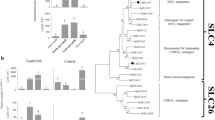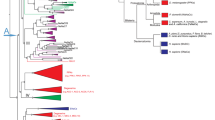Summary
During molting, the epithelium of the posterior caeca (PC) of the midgut in the terrestrial crustacean, Orchestia cavimana, is active in calcium turnover. In the preexuvial period, epithelial cells that progressively differentiate into cell-type III secrete ionic calcium (originating from the old cuticle) from the base to the apex of the cell within a typical extracellular network of channels; the calcium is then stored in the PC lumen as calcareous concretions. Immediately after exuviation, the epithelial cells rapidly differentiate into cell-type IV, reabsorbing calcium from the concretions through successive generations of spherites which quickly appear, grow, and then disappear from the apex to the base of the same extracellular network. The PC epithelium is thus alternatively calcium-loaded and unloaded. When the calcium-reabsorbing process is complete (average 48 h after exuviation), the epithelial cells again differentiate into two different regional cellular types (cell-type I in the distal segment and cell-type II in the proximal segment) characteristic of the intermolt period.
The dynamic changes in the PC epithelium during the postexuvial period are discussed, including the characteristic features of cell-type IV and of the reabsorption spherites.
Similar content being viewed by others
References
Abolins-Krogis A (1968) Shell regeneration in Helix pomatia with special reference to the elementary calcifying particles. Symp Zool Soc Lond 22:75–92
Abolins-Krogis A (1970) Electron microscope studies of the intracellular origin and formation of calcifying granules and calcium spherites in the hepatopancreas of the snail, Helix pomatia (L.). Z Zellforsch 108:501–515
Becker GL, Chen CH, Greenawalt JW, Lehninger AL (1974) Calcium phosphate granules in the hepatopancreas of the blue crab Callinectes sapidus. J Cell Biol 61:316–326
Beaulaton J (1968) Modifications ultrastructurales des cellules sécrétrices de la glande prothoracique du ver à soie au cours des 2 derniers âges larvaires. II — Le glycogène, ses relations avec le chondriome et le réticulum endoplasmique. J Microsc7:673–692
Berridge MG, Oschman JL (1972) Transporting epithelia. Academic Press New York, 1–91
Brown BE (1982) The form and function of metal-containing “granules” in invertebrate tissues. Biol Rev 57:621–667
Bubel A (1983) A fine structural study of the calcareous opercular plate and associated cells a polychaete annelid. Tissue Cell 15:457–476
Coombs TL, George SG (1978) Mechanisms of immobilization and detoxification of metal in marine organisms. In: DS McLusky, AJ Berry (Eds) Proceedings of the 12th European Symposium on Marine Biology, Stirling, Scotland, 1977. Pergamon Press, Eondon, pp 179–187
Durfort M (1978) Eocalizacion y ultraestructura del glucogéno en Mytilicola intestinalis, Steuer. (Crustacea Copepoda). Inv Pes 42:501–511
Durfort M (1981) Localizacion y ultraestructura del glucogéno y de las inclusiones lipidicas en el hepatopancreas y la gonada de Trachydermon cinereus, Thiele (Mollusca, Poliplacophora). Iberus 1:79–84
Espey LL, Stutts RH (1972) Exchange of cytoplasm between cells of the membrana granulosa in rabbit ovarian follicles. Biol Reprod 6:168–181
Fain-Maurel MA (1966) Eocalisations intramitochondriale et intracisternale de glycogène monoparticulaire. CR Acad Sci France 263:1107–1110
Garant PR (1972) The demonstration of complex gap junctions between the cells of the enamel organ with lanthanum nitrate. J Ultrast Res 40:333–348
Gibson R, Barker PL (1979) The dacapod hepatopancreas. In: M Barnes (Ed) Oceanography and marine biology. Aberdeen University Press, pp 329–346
Graf F (1968) Ee stockage de calcium avant la mue chez les Crustacés Amphipodes Orchestia (talitridé) et Niphargus (Gammaridé hypogé). Thèse Doct Sci Nat Dijon N∘ 105 Imp Berthier, Arch Orig Centre Document. CNRS n∘ 2690 1–216
Graf F (1971) Dynamique du calcium dans l'épithelium des caecums postérieurs d'Orchestia cavimana Heller (Crustacé, Amphipode). Rôle de l'espace intercellulaire. CR Acad Sci France 273:1828–1831
Graf F (1978) Extrusion massive de matériel nucléaire (par bourgeonnement ou directe) lors de l'inversion du sens de la sécrétion d'un epithelium de Crustacé. CR Acad Sci France, 287:1219–1222
Graf F, Meyran JC (1983) Premolt calcium secretion in midgut posterior caeca of the Crustacean Orchestia: ultrastructure of the epithelium. J Morphol 177:1–23
Graf F, Michaut P (1977) Ees sphérules calciques de l'épithélium caecal d'Orchestia (Crustacé, Amphipode), forme de transport de calcium dans le sens apico-basal. CR Acad Sci France 248:49–52
Graf F, Michaut P (1980) Fine structure of the midgut posterior caeca in the crustacean Orchestia in intermolt: recognition of two distinct segments. J Morphol 165:261–284
Guary JC, Negrel R (1981) Calcium phosphate granules: a trap for transuranic and iron in crab hepatopancreas. Comp Biochem Physiol 68:423–427
Hopkin SP, Nott JA (1979) Some observations on concentrically structured, intracellular granules in the hepatopancreas of the shore crab Carcinus moenas (L.). J Mar Biol Ass UK 59:867–877
Kapur SP, Gibson MA (1968) A histochemical study of the development of the mantle-edge and shell in the freshwater gastropod, Helisoma duryi eudiscus (Pilsbry). Canad J Zool 46:481–491
Larsen WJ (1977a) Gap junctions and hormone action. In: BL Gupta, RB Moreton, JL Oschman, BJ Wall (Eds) Transport of ions and water in animals. Academic Press, New York Eondon, pp 333–361
Larsen WJ (1977b) Structural diversity of gap junctions. A review. Tissue Cell 9:373–394
Merk FB, Botticelli CR, Albright JT (1972) An intercellular response to estrogen by granulosa cells in the rat ovary; an electron microscopic study. Endocrinology 90:992–1007
Merk FB, Albright JT, Botticelli CR (1973) The fine structure of granulosa cell nexuses in rat ovarian follicles. Anat Rec 175:107–125
Meyran JC, Graf F, Nicaise G (1984) Calcium pathway through a mineralizing epithelium in the crustacean Orchestia in premolt: ultrastructural cytochemistry and X-ray microanalysis. Tissue Cell 16:269–286
Neff JM (1972) Ultrastructure of the outer epithelium of the mantle in the clam Mercenaria mercenaria in relation to calcification of the shell. Tissue Cell 4:591–600
Petit H, Davis WL, Jones RG, Hagler HK (1980) Morphological studies on the calcification process in the fresh-water mussel Amblema. Tissue Cell 12:13–28
Shimizu M, Yamada J (1976) Light and electron microscope observations of the regenerating test in the sea urchin, Strongylocentrotus intermedius. In: N Watabe, KM Wilbur (Eds) Mechanisms of mineralization in the invertebrates and plants, University of South Carolina Press, pp 261–281
Simkiss K (1974) Calcium translocation by cells. Endeavour 33:119–124
Simkiss K (1976a) Intracellular and extracellular routes in biomineralization. Symp Soc Exp Biol 30:423–444
Simkiss K (1976b) Cellular aspects of calcification. In: N Watabe, KM Wilbur (Eds) Mechanisms of mineralization in the invertebrates and plants. University of South Carolina Press, pp 1–32
Simkiss K (1979) Metal ions in cells. Endeavour 3:2–6
Tompa AS, Watabe N (1976) Calcified arteries in a gastropod. Calcif Tiss Res 22:159–172
Towe KM (1972) Invertebrate shell structure and the organic matrix concept. Biomineralization 4:2–14
Travis DF (1957) The molting cycle of the spiny lobster Palinurus argus Latreille. VI. Post-ecdysial histological and histochemical changes in the hepatopancreas and integumental tissues. Biol Bull 113:451–479
Ueno M (1980) Calcium transport in crayfish gastrolith disc: morphology of gastrolith disc and ultrahistochemical demonstration of calcium. J Exptl Zool 213:161–171
Watabe N, Blackwelder PL (1980) Ultrastructure and calcium localization in the mantle epithelium of the freshwater gastropod Pomacea paludosa during shell regeneration. In: M Omori, N Watabe (Eds) The mechanism of biomineralization in animals and plants. Tokai Univ Press Tokyo, pp 131–144
Watabe N, Meenakashi VR, Blackwelder PL, Kurtz EM, Dunkelberger DG (1976) Calcareous spherules in the gastropod, Pomacea Paludosa. In: N Watabe, KM Wilbur (Eds) Mechanisms of Mineralization in the Invertebrates and Plants. University of South Carolina Press, pp 283–308
Author information
Authors and Affiliations
Rights and permissions
About this article
Cite this article
Graf, F., Meyran, JC. Calcium reabsorption in the posterior caeca of the midgut in a terrestrial crustacean, Orchestia cavimana . Cell Tissue Res. 242, 83–95 (1985). https://doi.org/10.1007/BF00225566
Accepted:
Issue Date:
DOI: https://doi.org/10.1007/BF00225566




